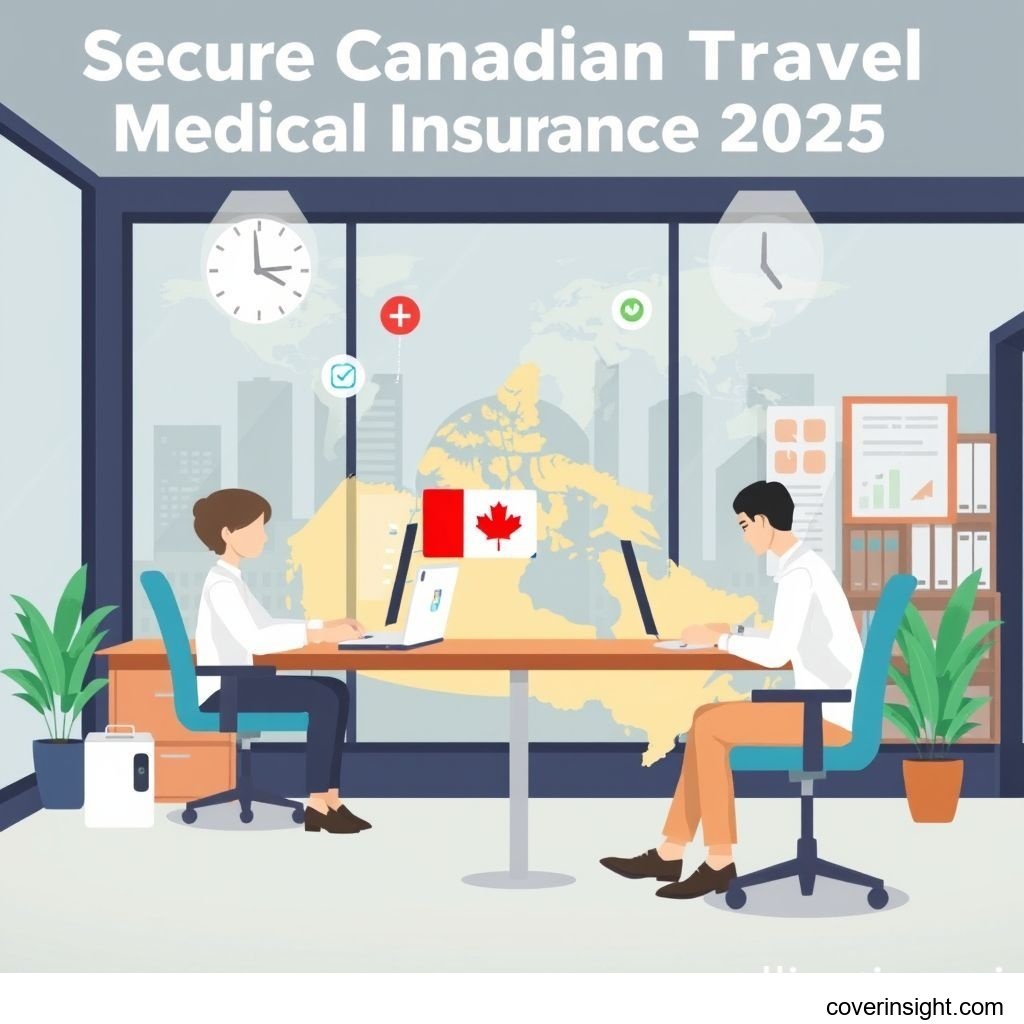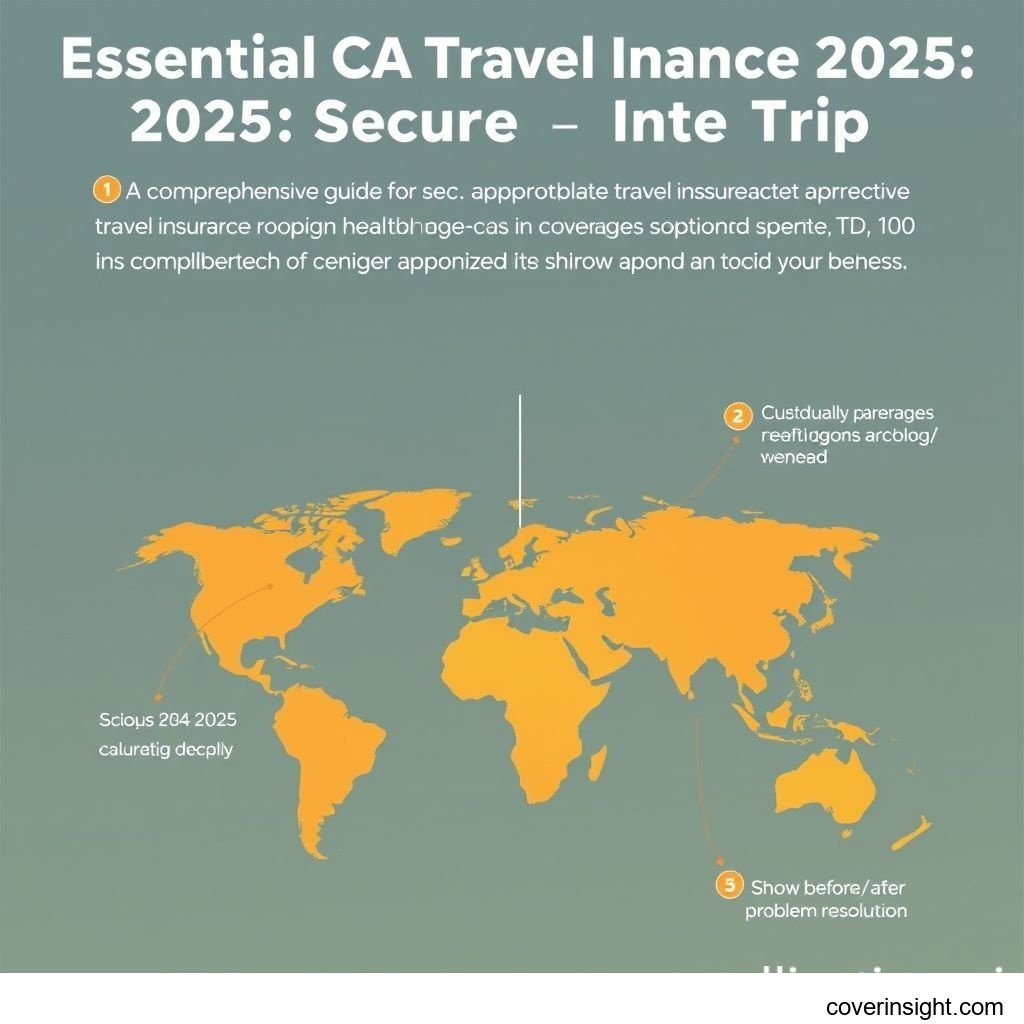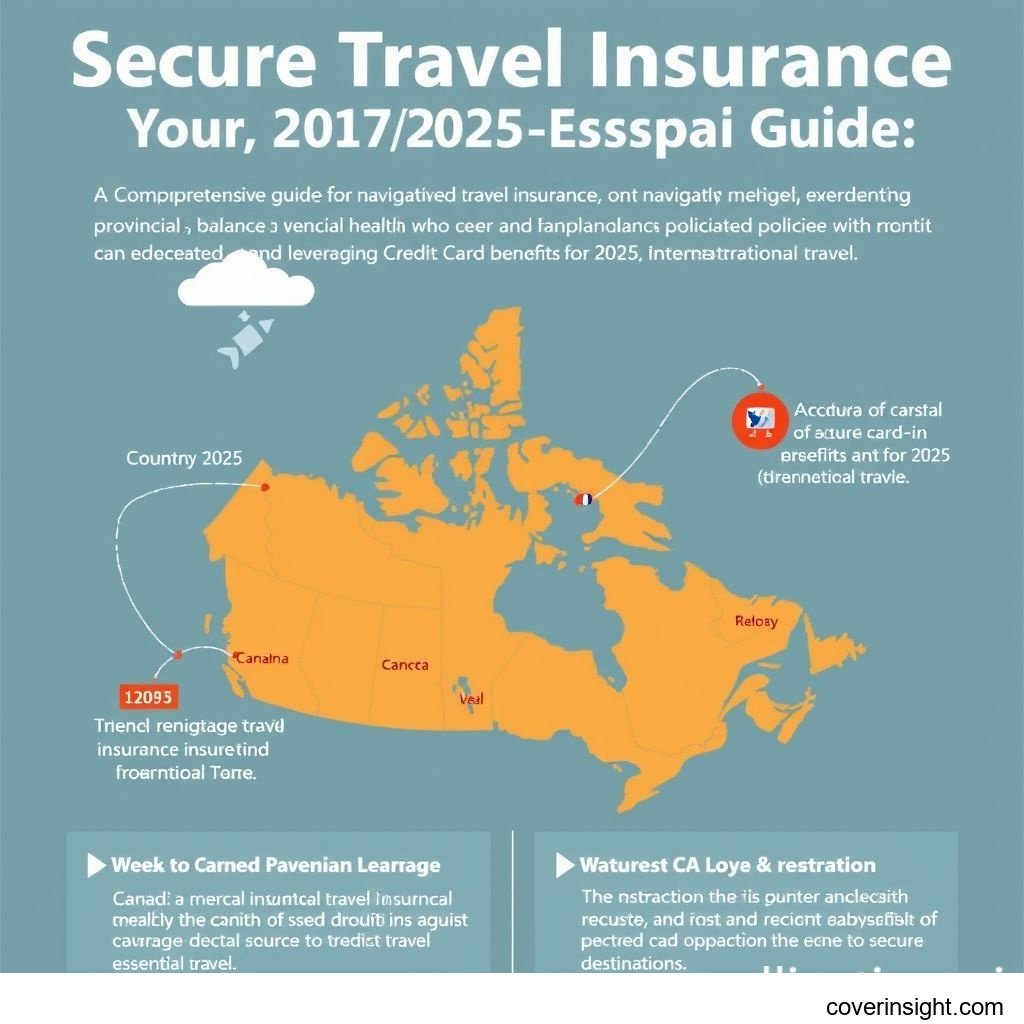Essential Travel Insurance for Canadians 2025
Introduction
As Canadians prepare for their adventures abroad in 2025, the foresight to acquire robust and secure travel insurance has never been more critical. Whether you're planning a sun-soaked escape, an adventurous trek, or an important business trip, understanding and securing the right coverage is paramount. Travel can be unpredictable, and while we all hope for smooth journeys, unforeseen events can quickly turn a dream vacation into a financial nightmare. From unexpected medical emergencies to lost luggage or trip cancellations, a comprehensive travel insurance policy acts as a vital safety net. This guide aims to provide a definitive resource for Canadians, highlighting essential aspects of securing adequate protection, navigating policy options, and making informed decisions for worry-free travel. For more general insights into global insurance resources, visit Insurance Resources Global.
Understanding Secure Travel Insurance Coverage
When selecting a policy, understanding what is covered, and equally important, what isn't, is crucial. A truly secure travel insurance plan provides peace of mind by addressing common risks associated with travel.
What’s Included in a Policy
Most comprehensive travel insurance policies offer a suite of benefits designed to protect travellers from a wide array of potential issues. Key inclusions typically involve:
-
Emergency Medical Expenses: This is often the cornerstone of any policy, covering doctor visits, hospital stays, surgeries, and prescription medications for unexpected illnesses or injuries occurring abroad. This is particularly vital as Canadian provincial health plans offer very limited coverage outside Canada.
-
Trip Cancellation/Interruption: Reimburses non-refundable expenses if your trip is cancelled or cut short due to covered reasons like illness, death in the family, or severe weather.
-
Baggage Loss/Delay: Provides compensation for lost, stolen, or damaged luggage, and sometimes for essential items purchased due to delayed baggage.
-
Travel Delay: Offers reimbursement for accommodations, meals, and other expenses incurred due to unexpected delays exceeding a specified period.
-
Accidental Death and Dismemberment (AD&D): Pays a lump sum benefit in the event of accidental death or loss of limb/sight during the trip.
-
Emergency Evacuation/Repatriation: Covers the costs of medical evacuation to the nearest suitable facility or repatriation back to Canada. It's essential to check medical evacuation limits as these can vary significantly between policies.
Common Exclusions and Limitations
While secure travel insurance offers extensive protection, it's equally important to be aware of common exclusions that could limit coverage. These often include:
-
Pre-existing Conditions: Many policies exclude or limit coverage for medical conditions that existed prior to purchasing the insurance, especially if they were unstable or untreated. Some providers offer waivers or specific plans for stable pre-existing conditions.
-
High-Risk Activities: Engaging in extreme sports (e.g., bungee jumping, heliskiing, mountaineering) may not be covered unless an add-on is purchased.
-
Alcohol/Drug-Related Incidents: Injuries or illnesses resulting from drug or alcohol abuse are typically excluded.
-
Acts of War or Terrorism: Travel to regions under government advisory due to political instability or war may invalidate coverage.
-
Elective Procedures: Cosmetic surgery or other non-emergency medical treatments are not covered.
-
"Cancel For Any Reason" (CFAR) Coverage: While highly flexible, this is an expensive add-on and usually doesn't offer 100% reimbursement. It's not standard in basic policies.
-
Pandemics/Epidemics: Following recent global events, many policies have updated their terms regarding coverage for risks associated with declared pandemics. Always review the latest policy wording carefully.
Understanding these exclusions ensures there are no surprises should you need to make a claim.
Cost Analysis and Saving on Secure Travel Insurance
The cost of secure travel insurance can vary widely based on several factors. Being aware of these influences can help you estimate expenses and find opportunities to save.
Factors Influencing Premiums
Several key elements contribute to the final price of your travel insurance premium:
-
Age of Traveller: This is arguably the biggest factor. Premiums generally increase with age due to higher perceived health risks.
-
Trip Duration: Longer trips naturally incur higher costs as they represent a longer period of risk for the insurer.
-
Destination: Travel to countries with high medical costs (e.g., USA) or higher political instability will typically result in higher premiums.
-
Type of Coverage: Comprehensive plans are more expensive than basic emergency medical-only policies. Specific add-ons for adventure sports or pre-existing conditions will also increase the price.
-
Deductible Amount: Choosing a higher deductible (the amount you pay out-of-pocket before insurance kicks in) can lower your premium.
-
Health Status/Pre-existing Conditions: If you have pre-existing conditions, you may pay more or need a specialized policy.
-
Number of Travellers: Family plans can sometimes offer cost savings compared to individual policies for multiple people.
Practical Saving Tips
While you shouldn't compromise on essential coverage, there are smart ways to save on your secure travel insurance:
-
Shop Around: Obtain quotes from multiple providers. Prices can vary significantly for identical coverage. Utilize online comparison tools.
-
Bundle Policies: If you travel frequently, an annual multi-trip policy might be more cost-effective than purchasing single-trip policies each time.
-
Increase Your Deductible: If you're comfortable with a higher out-of-pocket expense in case of a claim, a higher deductible will lower your premium.
-
Check Existing Coverage: Review any existing health insurance, home insurance (for baggage), or particularly your credit card travel insurance benefits before buying a new policy. You might already have some coverage.
-
Buy Early: While not directly a saving tip on the premium, buying your insurance shortly after booking your trip provides maximum coverage for trip cancellation benefits.
-
Group Discounts: If traveling with a large group, inquire about potential group discounts.
-
Maintain Good Health: While not always possible, stable health conditions generally lead to lower premiums, especially concerning pre-existing condition questionnaires.
Choosing the Right Secure Travel Insurance Policy
Selecting the best policy involves more than just comparing prices. It requires a thorough understanding of your needs and the nuances of various plans.
Comparing Providers and Plans
To ensure you get the most secure travel insurance, a detailed comparison is essential. Don't just look at the premium; dive into the policy details:
-
Read the Fine Print: Policy wordings can be complex, but they contain crucial information about what is and isn't covered. Pay close attention to definitions, conditions, and exclusions.
-
Check Customer Reviews and Ratings: Reputable insurers often have positive feedback regarding their claims process and customer service.
-
Understand Coverage Limits: Ensure the monetary limits for medical expenses, baggage, and other benefits are sufficient for your destination and potential needs. For instance, are the medical evacuation limits adequate for a worst-case scenario in a remote location?
-
Assess Emergency Assistance Services: A good policy includes 24/7 emergency support services that can coordinate medical care, evacuations, and provide travel advice.
-
Consider Your Travel Style: If you're an adventure seeker, ensure your policy covers the activities you plan to undertake. If you have specific health concerns, look for plans that accommodate pre-existing conditions.
-
Review Sub-Limits: Some policies have overall limits but also smaller "sub-limits" for specific items like prescription drugs or dental emergencies. Be aware of these.
Key Considerations and Medical Evacuation Limits
When choosing your policy, several specific aspects warrant extra attention:
-
Medical Evacuation Limits: This is critically important. If you're in a remote area or a country with inadequate medical facilities, you might need to be airlifted to a major city or even back to Canada. The cost of a medical evacuation can run into hundreds of thousands of dollars. Ensure your policy's medical evacuation limits are robust enough to cover this potential expense. A low limit here could leave you severely exposed.
-
Repatriation of Remains: While grim to consider, this coverage pays for the costs of returning your remains to Canada if you pass away abroad.
-
Trip Cancellation/Interruption Triggers: Understand the specific events that trigger these benefits. Is it just severe illness, or does it include natural disasters, political unrest, or even job loss?
-
Deductibles and Co-insurance: Be clear about how much you will pay out-of-pocket for a claim (deductible) and any percentage of costs you might be responsible for after the deductible (co-insurance).
-
Stability Period for Pre-existing Conditions: If you have pre-existing conditions and declare them, understand the "stability period" requirement. This specifies how long your condition must have been stable (without changes in medication, treatment, or symptoms) before your policy becomes effective for that condition.
Navigating Claims and Emergency Support
Even with the most secure travel insurance, the true test comes when you need to make a claim or require emergency assistance. A smooth process is key.
The Claims Process Explained
Filing a claim can seem daunting, but following these steps can make it easier:
-
Notify Your Insurer Immediately: Contact your insurance provider's emergency assistance line as soon as possible, especially for medical emergencies. They can guide you through the process and pre-approve certain treatments.
-
Gather Documentation: Keep meticulous records of everything:
-
Medical reports, diagnoses, and receipts for treatment.
-
Police reports for theft or lost items.
-
Airline letters for flight delays or lost luggage.
-
Original receipts for expenses incurred (e.g., emergency purchases, hotel bills).
-
Correspondence with airlines, tour operators, or medical facilities.
-
-
Complete Claim Forms Accurately: Provide all requested information truthfully and completely. Any discrepancies can delay or deny your claim.
-
Submit Your Claim: Submit all documentation within the timeframe specified by your policy, usually within 30-90 days of returning home or the incident date.
-
Follow Up: Keep a record of all communications with your insurer and follow up regularly until your claim is resolved.
Essential Emergency Assistance
Beyond financial reimbursement, a good secure travel insurance policy offers critical emergency support services:
-
24/7 Helpline: Access to a multilingual assistance team who can help in a crisis.
-
Medical Coordination: Assistance in finding suitable medical facilities, arranging appointments, and monitoring treatment.
-
Emergency Fund Transfer: Help arranging emergency funds if you run out of money abroad.
-
Legal Assistance: Referral to local legal professionals if needed.
-
Lost Document Support: Guidance on replacing lost passports or other vital documents.
These services are invaluable when you're in an unfamiliar environment and facing a stressful situation.
Credit Card Travel Insurance vs. Dedicated Policies
Many Canadians rely on credit card travel insurance for some level of protection. While convenient, it's crucial to understand its limitations compared to a dedicated policy.
Advantages and Limitations of Credit Card Coverage
Credit card travel insurance often comes as a perk with premium credit cards.
Advantages:
-
Convenience: Coverage is automatic if you charge your travel expenses to the card.
-
Cost-Effective: It's "free" as part of your annual credit card fee, avoiding separate premium payments.
-
Basic Coverage: May include trip cancellation, baggage insurance, and some emergency medical.
Limitations:
-
Limited Coverage: Typically offers lower benefit limits compared to dedicated policies, especially for medical emergencies and medical evacuation limits.
-
Short Duration: Often only covers trips up to a certain number of days (e.g., 15-30 days), which might not be suitable for longer travels.
-
Age Restrictions: Many credit card policies have strict age cut-offs (e.g., no coverage for travellers over 65 or 75), or significantly reduced benefits for older cardholders.
-
Pre-existing Conditions: Very strict or non-existent coverage for pre-existing conditions.
-
Activation Requirements: Requires specific booking methods (e.g., full trip cost charged to the card) to activate coverage.
-
Exclusions: Often has more exclusions for adventure activities or specific destinations.
-
No "Cancel For Any Reason": This feature is almost never included.
For general information on consumer protection, consult the Financial Consumer Agency of Canada.
When to Opt for a Dedicated Policy
While credit card travel insurance can provide a baseline, a dedicated, standalone policy is almost always recommended in the following scenarios:
-
Longer Trips: If your trip exceeds the typical duration limit of your credit card policy.
-
Older Travellers: Especially for seniors, dedicated policies offer more tailored and comprehensive medical coverage with clearer terms regarding age and pre-existing conditions.
-
High-Cost Trips: For expensive vacations, dedicated policies offer higher limits for trip cancellation/interruption and baggage.
-
Medical Concerns: If you have any pre-existing medical conditions, a dedicated policy is crucial to ensure you're adequately covered for related emergencies.
-
Adventure Travel: If you plan on participating in high-risk activities, a specialized policy or an add-on is necessary.
-
Peace of Mind: For ultimate peace of mind, knowing you have comprehensive, high-limit secure travel insurance specifically designed for your trip is invaluable.
For deeper insights into Canadian insurance industry standards, the Insurance Bureau of Canada is a valuable resource.
Frequently Asked Questions About Secure Travel Insurance
How much does secure travel insurance cost?
The cost of secure travel insurance varies significantly, typically ranging from 4% to 10% of your total non-refundable trip cost. However, factors like age, trip duration, destination, health status, and desired coverage level (e.g., higher medical evacuation limits) can push costs higher, especially for older travellers or those with pre-existing conditions.
What affects premiums?
Premiums are primarily affected by the traveller's age, the length and destination of the trip, the level of medical coverage needed, and any pre-existing medical conditions. The type of policy (single-trip vs. multi-trip, comprehensive vs. basic) also plays a major role. Choosing a higher deductible can reduce the premium.
Is it mandatory?
While secure travel insurance is not legally mandatory for Canadians leaving the country, it is highly recommended. Canadian provincial health plans provide very limited coverage outside Canada, leaving travellers vulnerable to massive medical bills if an emergency occurs. Some countries might require proof of insurance for visa applications.
How to choose?
To choose the best secure travel insurance, assess your specific needs (trip length, destination, health, activities). Compare quotes from multiple providers, carefully review policy wordings, and pay close attention to exclusions, deductibles, and coverage limits, particularly for emergency medical and medical evacuation limits. Don't solely focus on price; value comprehensive protection. Consider if your credit card travel insurance is sufficient, or if a dedicated policy is better. More information about specific Canadian insurance needs can be found at CA Insurance Home.
Consequences of no coverage?
Travelling without secure travel insurance carries significant risks. You would be personally responsible for all expenses related to medical emergencies (which can easily run into tens or hundreds of thousands of dollars), trip cancellations, lost luggage, or other unforeseen incidents. This financial burden can be catastrophic, potentially leading to debt or severe financial strain. It is a gamble not worth taking.









Comments